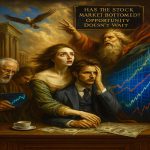Supertrends That Are Currently Affecting The Future of Business- AI Leads The Pack
Oct 27, 2024
Unveiling the Revolutionary Supertrends of the 21st Century
In an era when AI has surpassed $500 billion in market value and quantum computing threatens to shatter our fundamental understanding of data security, standing still means swift obsolescence. Welcome to the battlefield of the 21st century’s super trends—an arena where fortunes are made, and empires crumble at the speed of digital thought.
Consider this: By 2025, the AI market is projected to reach $1.8 trillion, while blockchain technology is revolutionizing everything from finance to supply chains. The metaverse, despite scepticism, attracted $120 billion in investments from tech giants in 2023 alone. These aren’t mere statistics—they’re battle lines being drawn in the sand of our digital future.
Let’s be clear: This isn’t another tepid analysis of gradual change. We’re witnessing a fundamental restructuring of global commerce, where companies like OpenAI can reach a $90 billion valuation in just four years, and digital insurgents ruthlessly dismantle traditional business models. The stakes? Nothing less than the complete reformation of how wealth is created, distributed, and maintained in the digital age.
In this analysis, we’ll dissect the super trends reshaping our world with surgical precision. From the rise of quantum-resistant cryptography to the emergence of autonomous corporations, we’re tracking the movements that will define the next decade of business evolution. This isn’t about predicting the future—it’s about understanding the forces that are already in motion and positioning ourselves to harness their momentum.
For the visionaries, strategists, and bold, these super trends represent unprecedented opportunity. For the hesitant and the traditional, they spell existential threat. The question isn’t whether these changes will impact your business—it’s whether you’ll be architecting the future or becoming another casualty of digital Darwinism.
Prepare to dive deep into the currents of change reshaping our world. This is your strategic blueprint for not just surviving but thriving in the age of digital revolution.
Digitization and the Rise of E-commerce
The digital revolution has transformed the way businesses operate, leading to the rise of e-commerce. This shift has been significantly accelerated by the COVID-19 pandemic, which forced businesses worldwide to adapt to online operations in response to lockdown measures and changing consumer behaviours.
A prime example of this trend is Amazon, a leading player in the e-commerce sector. The company’s net sales soared from $280.5 billion in 2019 to $386.1 billion in 2020, demonstrating the explosive growth of online retail. This surge in e-commerce is not confined to retail alone. It has permeated various sectors, including healthcare, where virtual consultations have become increasingly common.
The digitization of business operations and the rise of e-commerce are not just trends but a new norm. They represent a fundamental shift in how businesses interact with customers and how consumers access goods and services. This transformation has been driven by technological advancements, changes in consumer behaviour, and the need for businesses to remain competitive in an increasingly digital world.
The rise of e-commerce has also brought about significant changes in the retail landscape. Traditional brick-and-mortar stores are now competing with online retailers who can offer a broader range of products, competitive prices, and the convenience of shopping from home. This has led to a shift in consumer behaviour, with more people shopping online than in physical stores.
The Green Economy and Sustainability
In the face of growing global awareness about climate change and environmental degradation, sustainability has become a business imperative. This has given rise to the green economy, which is defined as low-carbon, resource-efficient, and socially inclusive. In a green economy, growth in employment and income are driven by public and private investments into economic activities, infrastructure, and assets that allow reduced carbon emissions and pollution.
Companies are now expected to integrate sustainable practices into their business models. This not only helps in reducing environmental impact but also provides a competitive advantage. Businesses that adopt green policies, technologies, and strategies could realize significant economic benefits.
A prime example of this trend is Tesla, an electric vehicle manufacturer. In 2023, Tesla sold nearly 1.5 million electric vehicles worldwide, up from just over 367,500 in 2019. This showcases how businesses can thrive while promoting sustainability.
This trend is influencing every sector, from renewable energy to sustainable agriculture, shaping the future of business. For instance, companies are developing new and refined business models for increased resource sharing and recycling.
Artificial Intelligence and Automation
Artificial intelligence (AI) and automation are transformative technologies revolutionizing businesses. From streamlining operations to enhancing customer experiences, AI and automation are integral to business strategies.
In 2023, the global AI market was valued at $62.4 billion and is projected to grow at a compound annual growth rate (CAGR) of 40.2% from 2024 to 2030. This super trend increases efficiency and reshapes job roles and workforce dynamics, significantly impacting the future of business.
The Gig Economy and Remote Work
The gig economy, characterized by flexible, temporary, or freelance jobs, is a significant trend shaping the future of business. This shift is transforming the traditional employer-employee relationship, offering more flexibility and freedom to workers. In a gig economy, people work part-time or temporarily or as independent contractors, providing more efficient services for those willing to use them. This trend has decoupled jobs and locations, allowing freelancers to take a job or project with an employer anywhere in the world.
Uber and Airbnb have built their business models around the gig economy, providing flexible work opportunities globally. These companies have redefined the concept of work, offering short-term commitments rather than salaried positions. This shift has allowed companies to select the best person for a specific job from a larger talent pool, altering the relationship between employer and employee.
The rise of remote work has further fueled this trend. The COVID-19 pandemic has normalized remote work, with major companies like Twitter offering employees the option to work from home indefinitely. This shift towards remote work has enabled people to work from anywhere, providing greater flexibility in their daily routine.
Personalization and Customer Experience
Personalization has emerged as a critical differentiator for businesses in today’s digital age, where information is abundant. By leveraging data analytics, companies can tailor their offerings to individual customer preferences, enhancing the customer experience and fostering loyalty. This approach allows businesses to engage with their customers personally, increasing customer satisfaction and loyalty.
A prime example of this trend is Netflix, a leading player in the streaming industry. Netflix’s recommendation algorithm personalizes content suggestions based on a user’s viewing history. Each user’s Netflix experience is unique and tailored to their tastes and preferences. This level of personalization enhances the user experience, making it more likely that they will continue to use the service and recommend it to others.
This trend of personalization extends beyond the entertainment industry. It is becoming the norm across sectors, influencing customer expectations and business strategies. Whether it’s a personalized marketing email, a product recommendation, or a tailored customer service interaction, businesses find that personalization can lead to increased customer engagement and loyalty.
In conclusion, personalization and customer experience are not just trends but a new norm. They represent a fundamental shift in how businesses interact with their customers. This shift has been driven by technological advancements, changes in consumer behaviour, and the need for businesses to remain competitive in an increasingly digital world.
Conclusion: Supertrends That Are Currently Affecting The Future of Business
In addressing the question of which super trends are currently shaping the future of business, we’ve delved into five influential trends: the rise of e-commerce through digitization, the green economy and sustainability, the gig economy and remote work, and the focus on personalization and customer experience.
These supertrends are not fleeting phenomena but fundamentally reshape the business landscape. By understanding and embracing these trends, businesses can stay ahead of the curve, seize new opportunities, and navigate the challenges of the 21st-century business environment.
These supertrends will continue to evolve, offering exciting prospects for innovation, growth, and transformation in the business landscape. Whether it’s the continued growth of e-commerce, the push for more sustainable business practices, the rise of the gig economy and remote work, or the increasing importance of personalization and customer experience, these trends will continue to define the future of business.
Remember, these trends are not isolated; they often intersect and influence each other. For example, the rise of e-commerce has been facilitated by advancements in digitization and has been affected by the gig economy through flexible delivery services. Similarly, the push for sustainability influences all sectors, from manufacturing to services, driving innovation and new business models.











